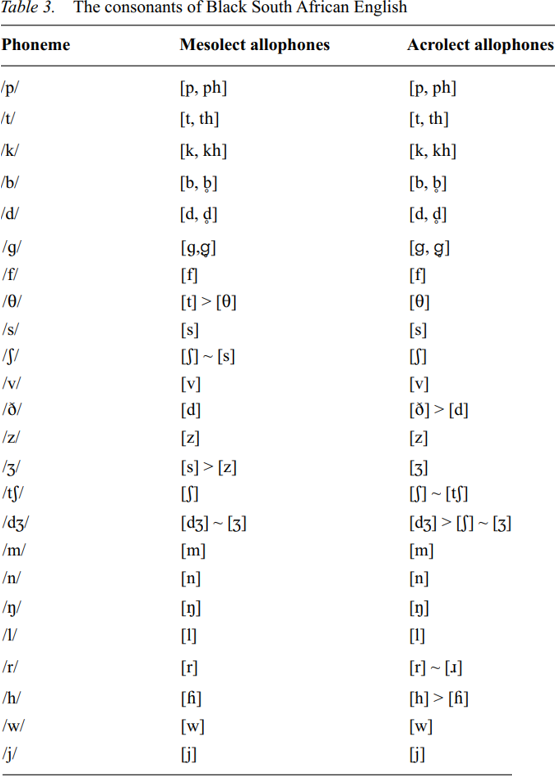


 Grammar
Grammar
 Tenses
Tenses
 Present
Present
 Past
Past
 Future
Future
 Parts Of Speech
Parts Of Speech
 Nouns
Nouns
 Verbs
Verbs
 Adverbs
Adverbs
 Adjectives
Adjectives
 Pronouns
Pronouns
 Pre Position
Pre Position
 Preposition by function
Preposition by function 
 Preposition by construction
Preposition by construction
 Conjunctions
Conjunctions
 Interjections
Interjections
 Grammar Rules
Grammar Rules
 Linguistics
Linguistics
 Semantics
Semantics
 Pragmatics
Pragmatics
 Reading Comprehension
Reading Comprehension|
Read More
Date: 2024-03-30
Date: 2024-04-24
Date: 2024-03-22
|
Hundleby (1963: 101) already claimed that the consonants of BlSAfE are more similar to native varieties of SAfE than the vowels, a claimed confirmed by most subsequent publications. The most important phonemes and allophones of mesolect and acrolect BlSAfE are presented in Table 3

Plosives in BlSAfE are similar to native varieties of SAfE in respect of manner and place of articulation. Final devoicing takes place very consistently, while regressive voicing assimilation is observed in the speech of Tswana speakers, but it is not certain if this is true for all BlSAfE speakers and has not been researched yet. A slightly more widespread distribution of word initial devoicing of [g] has been reported and observed in some of my data, but it is not a consistent phenomenon, and there is no suggestion of the neutralization of the voicing contrast between the phonemes /k/ and /g/. In the acrolect form, most of these features are maintained, so there is little difference between the two varieties of BlSAfE in this respect.
Aspiration occurs regularly, and is phonemic in all the Southern Bantu languages. In the mesolect, aspiration is present in slightly more than half of the syllable-initial plosive onsets (excluding those followed by sonorants before the nucleus vowel), while this increases to about three quarters in the acrolect. Some aspiration is also observed in other positions, but usually in less than a quarter of all cases.
The dental fricatives /θ,ð/ in mesolectal BlSAfE are usually realized as plosives, with both dental and alveolar articulations observed, but nothing further back towards the post-alveolar place of articulation, whereas in the acrolect two thirds or more of these phonemes are realized as fricatives, with some inter-speaker variation. The palatal fricatives /ʃ , Ʒ/ tend to become alveolar [s, z], particularly in the case of the voiced /Ʒ/, while the acrolectal speakers again approximate the phonetic quality of the native varieties of SAfE more closely. In the case of all these fricatives, the voiceless /θ/ and /ʃ/ are more likely to be realized as fricatives, while the voiced /ð/ and /Ʒ/ are more likely realized as plosives. Final devoicing also affects fricatives consistently in the acrolect and mesolect.
The affricates /ʧ , ʤ/ show lots of variation in the mesolect and the acrolect. In the mesolect, the voiceless /tʃ/ is realized as fricative [ʃ] in most cases, while /ʤ/ is realized by at least five different allophones, including [ʤ] and [ʃ] each occurring in about one third of the observed cases. In the acrolect, the allophones [tʃ] and [ʤ] occur in about half of all cases, with the fricative variants [ʃ] and [Ʒ] being observed in most other cases.
The sonorants are generally very similar to native varieties of SAfE. The nasals show little if any difference, while the liquid /l/ has some co-articulatory valorization in the environment of back vowels, but perhaps less so than in native varieties of SAfE. The rhotic /r/ is generally realized by a trilled [r] in the mesolect, and this remains the case in just more than half of all observed cases in the acrolect, although the approximant [ɹ] is observed in the remainder of the cases. The glottal sound /h/ is usually realized as a voiced  in the mesolect, but the acrolect is characterized by a voiceless [h] in the majority of cases. The other two glides, /j/ and /w/ are very similar in BlSAfE and native varieties of SAfE (cf. Van Rooy 2000).
in the mesolect, but the acrolect is characterized by a voiceless [h] in the majority of cases. The other two glides, /j/ and /w/ are very similar in BlSAfE and native varieties of SAfE (cf. Van Rooy 2000).
|
|
|
|
تفوقت في الاختبار على الجميع.. فاكهة "خارقة" في عالم التغذية
|
|
|
|
|
|
|
أمين عام أوبك: النفط الخام والغاز الطبيعي "هبة من الله"
|
|
|
|
|
|
|
قسم شؤون المعارف ينظم دورة عن آليات عمل الفهارس الفنية للموسوعات والكتب لملاكاته
|
|
|